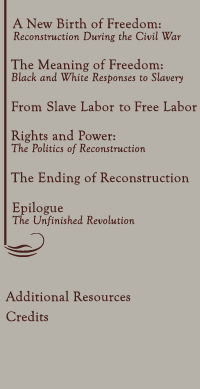





Introduction
Reconstruction was an era of unprecedented political conflict and of far-reaching changes in the nature of American government.
At the national level, new laws and constitutional amendments permanently altered the federal system and the definition of citizenship.
In the South, a politically mobilized black community joined with white allies to bring the Republican party to power, while excluding those accustomed to ruling the region.

The national debate over Reconstruction centered on three questions:
On what terms should the defeated Confederacy be reunited with the Union?
Who should establish these terms, Congress or the President?
What should be the place of the former slaves in the political life of the South?
 |
During the Civil War, Abraham Lincoln announced a lenient plan, with suffrage limited to whites, to attract Southern Confederates back to the Union. By the end of his life, however, Lincoln had come to favor extending the right to vote to educated blacks and former soldiers. |
| Lincoln's successor, Andrew Johnson, in 1865 put into effect his own Reconstruction plan, which gave the white South a free hand in establishing new governments. Many Northerners became convinced that Johnson's policy, and the actions of the governments he established, threatened to reduce African Americans to a condition similar to slavery, while allowing former "rebels" to regain political power in the South. |  |

As a result, Congress overturned Johnson's program.
Between 1866 and 1869, Congress enacted new laws and the Fourteenth and Fifteenth amendments to the Constitution, guaranteeing blacks' civil rights and giving black men the right to vote.
These measures for the first time enshrined in American law the principle that the rights of citizens could not be abridged because of race. And they led directly to the creation of new governments in the South elected by blacks as well as white - America's first experiment in interracial democracy.
Copyright
2003